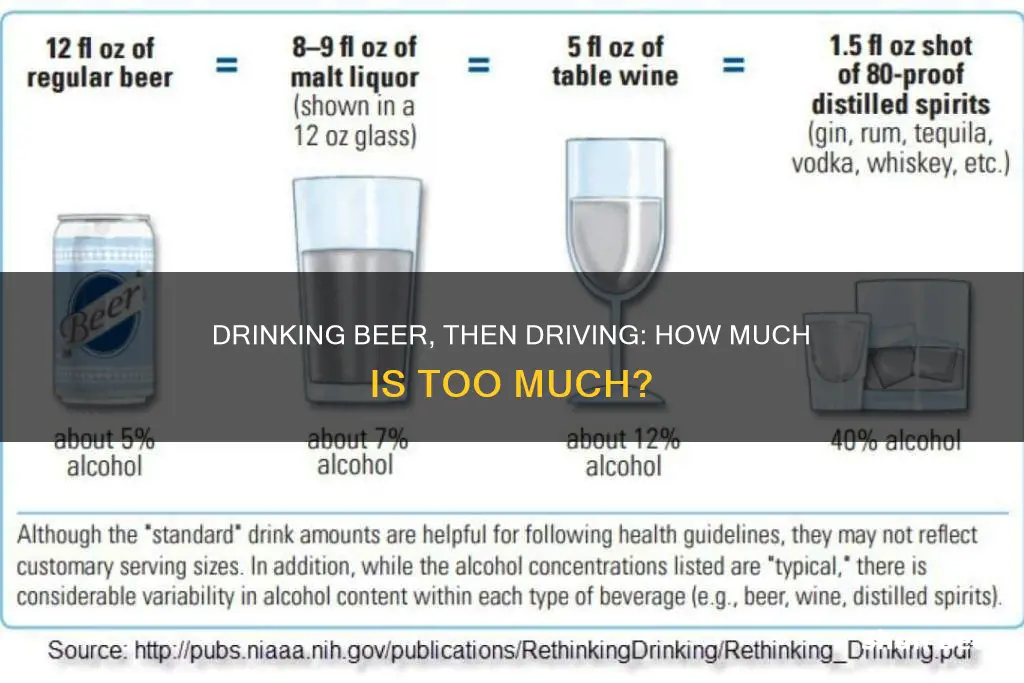
Drinking and driving is a dangerous combination. Alcohol affects your driving ability by impairing your judgment, slowing your reaction time, making it hard to focus on driving, affecting your ability to control the car or speed, reducing coordination, and inhibiting your ability to track moving objects. While the legal blood alcohol limit in the US is ~.08 g/dL, your driving skills can be affected even if you're under the limit. In fact, thousands of deaths are caused each year by drunk driving. So, if you've been drinking, it's best to avoid driving altogether and opt for a cab or public transportation instead.
| Characteristics | Values |
|---|---|
| Legal limit in the US | 0.08% BAC |
| Legal limit in Canada | 0.08% BAC |
| Legal limit in most European countries | 0.05% BAC |
| Legal limit in Saskatchewan, Canada | 0.04% BAC |
| Legal limit in the Yukon, Canada | 0.06% BAC |
| Legal limit in Ontario, Canada for drivers under 21 | 0% BAC |
| Metabolism rate | 1 drink per hour |
| Metabolism rate quantified | 0.016% BAC every hour |
| Time to metabolise a small shot of liquor | 1 hour |
| Time to metabolise a pint of beer | 2 hours |
| Time to metabolise a large glass of wine | 3 hours |
| Factors affecting metabolism rate | Age, biological sex, body weight, food consumption, medications, other substances |
What You'll Learn

Gender differences in blood alcohol content
It is important to note that there are many variables that affect an individual's Blood Alcohol Content (BAC). These include age, weight, gender, time of day, food consumption, and metabolic rate. Even the volume of alcohol in a drink can vary, with some craft beers containing a significantly higher alcohol percentage.
In general, women tend to become intoxicated more quickly than men and remain intoxicated for longer. This is due to a variety of factors, including differences in body composition and metabolism. Women tend to have a higher body fat percentage and lower water percentage than men, and since alcohol is dispersed in body water, women tend to reach higher BACs than men after consuming equivalent doses of alcohol, even when adjusted for body weight. Additionally, women have lower levels of the enzyme alcohol dehydrogenase, which is produced in the liver and breaks down alcohol.
To provide a specific example, a 180-lb man may be able to drink 3.5 regular 12-ounce beers in one hour and maintain a BAC below the legal limit of 0.08%. On the other hand, a 140-lb woman may only be able to consume 2.5 regular beers in an hour and stay under the same BAC limit. It is important to note that these are general estimates and can vary depending on other factors.
Beer and MMS: A Safe Mix?
You may want to see also

Weight and body size considerations
When considering how much beer you can drink before driving, weight and body size are crucial factors. The amount of alcohol that can be safely consumed before driving varies from person to person and is dependent on a number of factors, including gender, metabolism, body fat percentage, and weight. Individuals with a larger body size and more muscle mass tend to process alcohol differently compared to those with a smaller frame.
In general, individuals with a heavier weight or larger body size will require more alcohol to reach the same blood alcohol concentration (BAC) as someone who is lighter or has a smaller frame. This is because alcohol distributes itself throughout the body and is diluted in a larger volume of blood and body water in larger individuals. As a rule of thumb, men tend to have a higher water content in their bodies compared to women, which means that for the same weight, a man's BAC will tend to be lower than a woman's.
However, it's important to note that this relationship is not linear. While weight and body size do play a significant role, they are not the only factors at play. Metabolism, for example, can vary greatly from person to person, regardless of their size. Some people metabolize alcohol more quickly, meaning it leaves their system faster, while others may process alcohol more slowly, leading to a higher BAC. Additionally, the amount and type of food consumed, as well as the presence of certain medications or drugs, can also influence how alcohol is absorbed and metabolized.
Individuals with a higher body fat percentage tend to reach higher BAC levels faster. This is because alcohol is water-soluble and distributes throughout the body's water content. Since fat tissue contains very little water compared to muscle tissue, a higher proportion of alcohol will be present in the bloodstream of an individual with more body fat, leading to a higher BAC. As such, two people of the same weight but different body compositions may have very different BAC levels after consuming the same amount of alcohol.
It's important to remember that these are general guidelines, and individual factors can vary significantly. The only sure way to avoid drunk driving is to abstain from drinking alcohol if you plan to drive or to use alternative transportation methods if you intend to consume alcohol. It is always better to err on the side of caution when it comes to drinking and driving, as the consequences can be severe and life-altering.
Beer and Malt Allergies: Can You Still Drink Beer?
You may want to see also

section on metabolic rate
Metabolic rate is a crucial factor in determining how alcohol is processed by the body. It is influenced by various factors, including age, biological sex, body weight, food consumption, and drinking speed. Understanding these factors can help individuals make informed decisions about drinking and driving.
Age
The rate at which alcohol is metabolised slows down as people age due to decreased circulation, lower muscle mass, and other physiological changes. This means that older individuals may take longer to process alcohol and return to a safe Blood Alcohol Concentration (BAC) level for driving.
Biological Sex
Females tend to metabolise alcohol differently and experience its effects more strongly than males, even when they are of the same size. This is due to physiological factors such as lower body water volume, hormonal differences, and lower levels of specific liver enzymes that break down alcohol. As a result, women may reach higher BAC levels faster and need more time to process alcohol.
Body Weight
Body weight also plays a significant role in alcohol metabolism. Heavier individuals tend to have more space for alcohol diffusion in the body, which means that a person with a lower weight will have a higher concentration of alcohol in their blood even if they consume the same amount as someone heavier. Therefore, weight can significantly impact how long it takes to process alcohol and return to a safe BAC level.
Food Consumption
Consuming food before or while drinking can significantly impact alcohol metabolism. Food in the stomach slows down gastric emptying and reduces alcohol absorption. A full stomach can lead to a lower BAC level compared to drinking on an empty stomach. Additionally, certain types of meals, such as those high in fat, carbohydrates, or protein, can further delay gastric emptying and reduce alcohol absorption.
Drinking Speed
Drinking speed also influences metabolic rate. When alcohol is consumed rapidly, such as through shots or chugging, the liver doesn't have sufficient time to process it. This results in longer-lasting effects and a higher BAC level. Sipping drinks slowly and alternating with non-alcoholic beverages can help maintain a lower BAC level.
Individual Variation
It is important to remember that every individual is unique, and their body chemistry, muscle and fat densities, and metabolic rates can vary. Some people may process alcohol faster or slower than others, and there is no one-size-fits-all rule. Additionally, factors such as height, weight, and body composition can also influence how alcohol is metabolised and the time it takes to return to a safe BAC level for driving.
Practical Considerations
While there is no practical way to speed up alcohol metabolism, individuals can take certain steps to manage their drinking and ensure they stay within legal limits. These include setting a drink limit before starting, sipping drinks slowly, choosing beverages with lower alcohol content, and having something to eat before and while drinking. If there is any doubt about sobriety, it is always best to err on the side of caution and avoid driving.
Beer and Kidney Stones: Is Drinking Safe?
You may want to see also

Food consumption and drinking
Food consumption plays a significant role in determining how much alcohol you can consume before driving. It is advised to never drink on an empty stomach as alcohol is quickly absorbed through the stomach lining. Eating a meal before drinking and having snacks while drinking can help slow down the absorption of alcohol. However, it is important to note that food consumption is just one of many factors that influence how alcohol affects your body and your Blood Alcohol Concentration (BAC).
The rate at which your body metabolizes alcohol is a crucial factor. On average, the liver can process around one ounce of liquor per hour or one standard drink. This rate varies depending on several factors, including age, biological sex, body weight, and other substances or medications consumed. As people age, slowed circulation and lower muscle mass affect how alcohol is distributed, metabolized, and eliminated from the body. Females tend to metabolize alcohol differently and will feel the effects more than males, even if they are the same size. This is due to lower body water volume, hormonal factors, and lower levels of liver enzymes that break down alcohol. Additionally, the more a person weighs, the more space there is for alcohol to diffuse in the body, resulting in a lower concentration of alcohol in the blood.
It is important to understand that the number of drinks you can consume before driving is not a precise science and can vary significantly from person to person. For example, a 180-lb man may be able to drink 3.5 regular 12-ounce beers in an hour and maintain a BAC under the legal limit of 0.08%. On the other hand, a 140-lb woman may only be able to consume 2.5 regular beers in an hour and stay within the legal limit. These estimates assume an average beer with a 5% alcohol by volume (ABV) level and do not consider other factors such as metabolic rate and the type of beer consumed.
Different types of beer, such as craft IPAs, stouts, and ales, often have higher ABV levels, which would impact the amount you can consume before driving. Additionally, light beers typically have a lower ABV of around 4.2%, allowing individuals to potentially drink more while staying under the legal BAC limit. It is worth noting that non-alcoholic beers do not have a limit, and you can consume as many as you like without legal repercussions.
While there are general guidelines and estimates, it is challenging to predict a person's BAC accurately due to the various factors that come into play. The only sure way to avoid the risks associated with drinking and driving is to refrain from drinking altogether if you plan to drive or make alternative transportation arrangements. Remember, the effects of alcohol can impair your judgment, so it is always better to err on the side of caution and not get behind the wheel if you have any doubts about your sobriety.
Beers and Driving: How Many is Too Many?
You may want to see also

Alcohol by volume (ABV) in different drinks
Alcohol by volume (ABV) is a metric used to determine the alcohol content in an alcoholic beverage. It is a standard measure of the volume of alcohol in a given volume of an alcoholic drink, expressed as a volume percentage.
Beer
Beers typically have an ABV between 3.5% and 7%, but some have less than 1%, while certain IPAs can have an ABV of over 10%. Light beers have an average ABV of 4.2%. Beer contains between 4% and 7% ABV, with the average being 5%. A 12-ounce beer with 5% ABV contains 0.6 ounces of alcohol.
Wine
The average ABV of wine is around 12%, but this varies depending on the type of wine. Sparkling wines and white wines tend to have an ABV of around 10%, while red wines and orange wines usually have an ABV of around 14%. Fortified wines, which have distilled grape spirits added during the fermentation process, can have an ABV of around 20%. A 5-ounce glass of 12% ABV wine contains 0.6 ounces of alcohol.
Spirits/Liquor
Liquor has some of the highest ABV levels of alcoholic beverages, with most liquors falling between 40% and 50% ABV. Fruit liqueurs typically have an ABV ranging from 28% to 32%, gin from 35% to 40%, vodka from 35% to 46%, and whiskey, rum, and tequila from 40% to 46%. Cask-strength whiskey can have an ABV of 55% to 60%. A shot of liquor (1.5 ounces) with 40% ABV contains 0.6 ounces of alcohol.
Other Alcoholic Drinks
Hard cider typically has an ABV between 4.5% and 7%. Malt liquor usually has an ABV of around 7%.
Factors Affecting Blood Alcohol Content (BAC)
It's important to note that the amount of alcohol consumed is not the only factor affecting BAC. Other variables include a person's age, weight, gender, metabolic rate, time of day, and food consumption. The legal driving limit in all 50 states in the US is a BAC of 0.08 or more, but impairment can begin at lower levels, and the effects of alcohol can vary from person to person. It is always best to avoid driving after consuming alcohol.
Cancer Patients and Beer: What's Safe to Drink?
You may want to see also
Frequently asked questions
The legal blood alcohol content (BAC) limit in the US is .08 g/dL. However, there is no safe amount of alcohol to consume before driving. Alcohol affects your judgement, slows your reaction time, and makes it difficult to focus on driving, among other things. The safest option is to not drink any alcohol if you plan to drive.
This depends on several factors, including your weight, gender, metabolic rate, and whether you have consumed any food. For example, a 180-lb man may be able to drink 3.5 regular 12-ounce beers in an hour and stay under the legal limit, while a 140-lb woman may be able to consume 2.5 beers in an hour. However, these are just estimates, and the actual number may vary.
It takes the body approximately two hours to metabolize one pint of beer. However, this can vary depending on factors such as age, gender, weight, and food consumption. The only way to ensure that you are sober enough to drive is to wait it out or not drink any alcohol at all.
The legal blood alcohol content (BAC) limit for driving in the US is .08 g/dL. However, even if you are below this limit, your driving skills can still be impaired, and you can be charged with driving under the influence (DUI).
There is no reliable way to test your sobriety after drinking. Alcohol affects your judgement, so you may not be able to accurately evaluate your driving skills. The safest option is to refrain from drinking altogether if you plan to drive.







